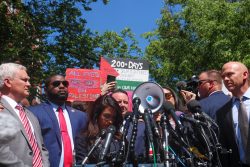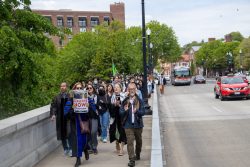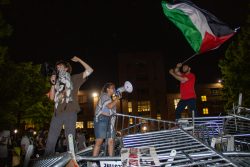This morning, Georgetown students received an e-mail announcing that, regardless of what the Office of Housing Services office told them last year, they now have four years of guaranteed on-campus housing. With the completion of the much-awaited Southwest Quadrangle in the fall of 2003, the University will be able to accommodate 780 more students than it has in the past.
Despite the Housing Office’s e-mail, the now-thriving off-campus student culture will not die away immediately. For one, many rising juniors and seniors have already signed their leases for next year, thereby excluding them from the upcoming lottery. Moreover, the University has factored in the number of students estimated to be abroad, as well as an estimate of the number of students who will choose to live off campus despite housing guarantees. With all these factors accounted for, the Housing Office can safely say: “We will have enough space to accommodate all students who want to live on campus.” Let’s hope they’ve got their numbers right.
For incoming generations of students, four years of guaranteed housing may become an accepted part of life. In reality, however, the decreased number of students inhabiting the homes of Burleith and West Georgetown has been a long time coming for many area residents.
Members of the Advisory Neighborhood Commission, the Burleith Citizens Association, the Alliance for Local Living and several other groups have been pressuring the University for years to decrease the number of students living off campus. Just last spring, the Cloisters West Homeowners Association voted to limit the number of students who could reside in their gated community.
The biggest proponent of decreasing the number of students living off campus, however, has been the D.C. Board of Zoning and Adjustment. In August 2000, after reviewing the University’s Ten Year Plan, the BZA denied the University’s request for an enrollment increase of 389 students. The reason? They didn’t want any more students flooding the neighborhood.
Unfortunately for the University, the enrollment increase is essential for the realization of the Ten Year Plan. In March 2000, Vice President for Student Affairs Juan Gonzalez said that without the extra revenue generated by the increase in enrollment, the University cannot complete all of its planned construction. The Ten Year Plan proposed that, upon the completion of the Southwest Quad, the University would begin phasing in the enrollment increase over a seven-year period. In 2010, with the enrollment increase complete, the Plan predicts that 16 percent of students would live off campus.
Last spring, the BZA completed its role in the University’s Ten Year Plan?as of then, its board members still had not agreed to compromise on the proposed conditions. So far, it looks like the anti-student neighbors among us have won. There will be a visibly smaller off-campus undergraduate population in the near future, and there won’t even be more students on campus! No more being awakened by drunk students! No more trash cans overflowing with beer cans! Let’s party! No wait, that’s what students do.
The University is currently in the long process of presenting its case to the D.C. Court of Appeals. If its appeal is rejected, one can only imagine where the University will find the money to finance its plan.
Higher tuition, anyone?




